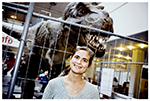Dinosaurs on Display and Dissemination of Paleontology
– An Exploration of ‘Science in the Making’ in Exhibition Design
PhD defence by Eliza Jarl Estrup
 Geocenter Møns Klint and the Department of Science Education, University of Copenhagen announce the public defence of the PhD-thesis ” Dinosaurs on Display and Dissemination of Paleontology – An exploration of ‘Science in the Making’ in Exhibition Design” by Eliza Jarl Estrup.
Geocenter Møns Klint and the Department of Science Education, University of Copenhagen announce the public defence of the PhD-thesis ” Dinosaurs on Display and Dissemination of Paleontology – An exploration of ‘Science in the Making’ in Exhibition Design” by Eliza Jarl Estrup.
The public defence takes place at 13:00-16:00 in the auditorium at the Geological Museum, Øster Voldgade 5-7, 1350 København K. The defence is followed by a reception at the Department of Science Education, Øster Voldgade 3, 1350 København K.
Supervisors
Marianne Achiam, Associate Professor, DSE
Robert Harry Evans, Associate Professor, DSE
Assessment commitee
Heather King, Science Education Lecturer, Kings College London, UK
Lucy Avraamidou, Associate Professor, University of Groningen, the Netherlands
Carl Winsløw, Professor, University of Copenhagen, Denmark
Abstract
Dinosaurs have always had the ability to fascinate. Even so, paleontology and its origin in natural history is not currently being acknowledged as content matter by the educational system, which frequently portrays science as a monolithic and experimental endeavour. In the current dissertation, I present the unique qualities and educational significance of paleontology in especially the out-of-school context of museum exhibitions, and make a case for its reintroduction to the educational system as a whole. I additionally investigate the popularity of dinosaurs in exhibitions, by asking a number of decision-makers behind recent dinosaur exhibitions, on which grounds they chose dinosaurs as their displayed content.
Paleontology holds particular qualities regarding the dissemination of authentic scientific inquiry (in addition to traditional displays of authentic objects - fossils). As such, inquiry-based activities and documentation of 'science in the making' rather than 'ready-made science' are on the rise in the dissemination of paleontology in exhibitions. The middle section of the current dissertation investigates the development and design process of such a 'science in the making' exhibition, and subsequently the visitor outcomes of the resulting exhibition - in comparative analysis with a second ' science in the making' dinosaur exhibition. Qualitative and quantitative studies in triangulation suggest that the ontological status of 'science in the making' has an enhancing effect on scientific literacy in visitors, albeit differences in the design strategy were detected in correspondence with the nature of the institution in question. The museological design strategy reflects an inductive approach with anchorage in objects and disciplinary features, whereas the design strategy of science centers reflects a deductive approach with anchorage in discovery pedagogy and hands-on exhibits.
The final section of the dissertation integrates the design strategies into a practical evidence-based design model, based on co-determinative levels found to have been of influence to the design process, and uses a case study of an inquiry-based exhibit element as an example of its application. The design model is applicable to the design process of ‘science in the making' exhibitions, and it is developed with the intention of supporting collaborative efforts between theorists and practitioners within exhibition design in the future.
